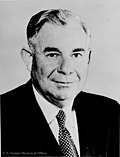Campaign
After becoming a member of the Phoenix City Council in 1949, [5] Barry Goldwater assumed a position as campaign manager of fellow Republican John Howard Pyle's successful 1950 bid for Governor of Arizona. After Pyle's narrow victory in the 1950 election, Goldwater began exploring the possibility of running for higher office himself and won re-election to his seat on the Phoenix Council by a comfortable margin. Goldwater's interest compounded in 1951, the same year he won re-election to his council seat, when Illinois U.S. Senator Everett Dirksen visited Phoenix. Goldwater, while at a cocktail party for Dirksen, was approached by the Illinois Senator, who encouraged him to run for Incumbent Democratic Senator Ernest McFarland's seat. Goldwater said later that he had estimated his chances at winning the election to be fifteen-to-one. Nonetheless, Goldwater began conducting research on McFarland and studied the election returns of Howard Pyle's 1950 gubernatorial victory, leading him to re-estimate his chances to be fifty-fifty. [3]
Goldwater had been campaigning for several months before formally announcing his candidacy for McFarland's U.S. Senate seat on April 24, 1952. In his formal announcement, Goldwater cited six reasons for his entering the Senate race: his belief "that a life-long familiarity with the State of Arizona and its people and intensive study of the problems and needs of this region as a businessman and citizen qualifies me to represent efficiently our state in Washington," [3] his opposition to the expansion of the federal government and belief in states' rights, his opposition to the New Deal and Fair Deal programs, his belief that a U.S. Senator should not be "a mere rubber stamp for any administration," [3] and his opposition to the "present tragic trend toward the destruction of individual freedom." [3]
The divisive race between Dwight Eisenhower and Robert A. Taft for the Republican nomination in the 1952 presidential race became cause for concern for state Republicans, Goldwater in particular. He confided to an associate of the Republican National Committee, Clarence Buddington Kelland, that he believed the Democrats were beginning to benefit from the "constant bickering" [3] within the party. This, believed Goldwater, was the best-case scenario for the Democrats, including McFarland, who was hindered in his bid for re-election by the unpopularity of the Truman administration. [3]
Originally believing he could run a campaign on his own with relatively few resources, Goldwater hired a campaign manager in June 1952, Stephen Shadegg, who had previously worked on the campaign of Democratic U.S. Senator Carl Hayden. Goldwater also received financial and logistical help from the Republican National Committee and the Republican Senatorial Campaign Committee, as well as additional financial backing from prominent Republicans, including Sid Richardson and H. L. Hunt, [3] and easily defeated his sole opponent, Lester Kahl, in the Republican primary on September 8. [6] [7] Goldwater employed a general election strategy of focusing get out the vote efforts on the three northernmost counties of Arizona, inhabited primarily by the Navajo and Hopi Native American peoples. Feeling the margin would be close in the election results, Goldwater believed these efforts, especially efforts to organize a voter registration campaign in the northern counties, to be crucial for victory, writing to Everett Dirksen in May that "this might well be the margin of victory in this state." [3]




